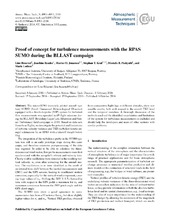| dc.contributor.author | Båserud, Line | |
| dc.contributor.author | Reuder, Joachim | |
| dc.contributor.author | Jonassen, Marius Opsanger | |
| dc.contributor.author | Kral, Stephan | |
| dc.contributor.author | Bakhoday Paskyabi, Mostafa | |
| dc.contributor.author | Lothon, Marie | |
| dc.date.accessioned | 2017-08-04T13:01:20Z | |
| dc.date.available | 2017-08-04T13:01:20Z | |
| dc.date.issued | 2016-10-06 | |
| dc.Published | Båserud L, Reuder J, Jonassen MO, Kral ST, Bakhoday Paskyabi M, Lothon M. Proof of concept for turbulence measurements with the RPAS SUMO during the BLLAST campaign. Atmospheric Measurement Techniques. 2016;9(10):4901-4913 | eng |
| dc.identifier.issn | 1867-8548 | en_US |
| dc.identifier.uri | https://hdl.handle.net/1956/16222 | |
| dc.description.abstract | The micro-RPAS (remotely piloted aircraft system) SUMO (Small Unmanned Meteorological Observer) equipped with a five-hole-probe (5HP) system for turbulent flow measurements was operated in 49 flight missions during the BLLAST (Boundary-Layer Late Afternoon and Sunset Turbulence) field campaign in 2011. Based on data sets from these flights, we investigate the potential and limitations of airborne velocity variance and TKE (turbulent kinetic energy) estimations by an RPAS with a take-off weight below 1 kg. The integration of the turbulence probe in the SUMO system was still in an early prototype stage during this campaign, and therefore extensive post-processing of the data was required. In order to be able to calculate the three-dimensional wind vector, flow probe measurements were first synchronized with the autopilot's attitude and velocity data. Clearly visible oscillations were detected in the resulting vertical velocity, w, even after correcting for the aircraft motion. The oscillations in w were identified as the result of an internal time shift between the inertial measurement unit (IMU) and the GPS sensors, leading to insufficient motion correction, especially for the vertical wind component, causing large values of σw. Shifting the IMU 1–1.5 s forward in time with respect to the GPS yields a minimum for σw and maximum covariance between the IMU pitch angle and the GPS climb angle. The SUMO data show a good agreement to sonic anemometer data from a 60 m tower for σu, but show slightly higher values for σv and σw. Vertical TKE profiles, obtained from consecutive flight legs at different altitudes, show reasonable results, both with respect to the overall TKE level and the temporal variation. A thorough discussion of the methods used and the identified uncertainties and limitations of the system for turbulence measurements is included and should help the developers and users of other systems with similar problems. | en_US |
| dc.language.iso | eng | eng |
| dc.publisher | Copernicus Publications | en_US |
| dc.rights | Attribution CC BY | eng |
| dc.rights.uri | http://creativecommons.org/licenses/by/3.0/ | eng |
| dc.title | Proof of concept for turbulence measurements with the RPAS SUMO during the BLLAST campaign | en_US |
| dc.type | Peer reviewed | |
| dc.type | Journal article | |
| dc.date.updated | 2017-05-10T07:35:23Z | |
| dc.description.version | publishedVersion | en_US |
| dc.rights.holder | Copyright 2016 The Author(s) | en_US |
| dc.identifier.doi | https://doi.org/10.5194/amt-9-4901-2016 | |
| dc.identifier.cristin | 1390671 | |
| dc.source.journal | Atmospheric Measurement Techniques | |

